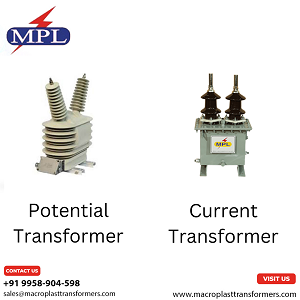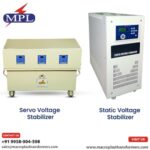MACROPLAST is a highly reputable and trusted manufacturer, and supplier of current and potential transformers (voltage transformers). These transformers are of international standards and offer optimum performance. Designed using quality raw materials and high-tech technologies, these transformers is long-lasting.
Let’s take a quick look at the differences between the Current Transformer and Potential Transformer based on types, connection, rate winding, use, core, and so on.
Difference based on Use
A current transformer allows using a 5 Ampere ammeter when it comes to measuring high currents as 200 amperes. In contrast, a potential transformer is designed to use a 120-voltmeter to measure high voltage like 11KV.
Difference based on Types
While current transformers have two types, wound and closed core. Potential transformers are divided into two categories. They are capacitor voltage and electromagnetic.
Difference based on Connection
The primary winding in the current transformer is connected in series to the transmission line whose current is to be measured. Full-line current flows via the winding. On the other hand, the potential transformer is connected in parallel with the circuit. It means full line voltage appears across the winding.
Difference based Transformation Ratio
When it comes to the transformation ratio, it is high in a current transformer whereas it is low in the potential transformer.
Primary & Secondary Winding
The primary winding has less number of turns in a current transformer. And the current can be measured. Potential transformers come with many primary winding turns. The voltage can be measured.
In a current transformer, the secondary winding possesses large numbers of turns on the secondary side and is connected to the current winding of the instrument. In a potential transformer, the secondary winding has a small number of turns on the secondary side and is connected to the meter or instrument.
Differences based on Burden
The current transformer is designed in a way that it does not depend on the secondary burden, whereas the potential transformer majorly depends on it.
Differences based Core
Silicon steel lamination is the material used to design the current transformer. On the other hand, top-quality steel operating flux densities are used to manufacture a potential transformer.
Current Transformer and Potential Transformer Manufacturer
As one of the leading manufacturers of Current Transformers and Potential Transformers, MACROPLAST makes top-quality transformers. We are also one of the leading Current Transformer Suppliers and Potential Transformer Suppliers in India, Tanzania, Kenya, Mozambique, African and EU countries. The current transformer designed by us can be majority used to reduce a high current to a safer and more manageable level that can be measured. It has the potential to convert primary currents into small 1A/5A currents.
On the other hand, the potential transformer designed by Macroplast can measure and rescue high voltage values into lesser values. It has the potential to convert the high voltage into a standard secondary voltage of 100V or lower.
Macroplast Transformer manufactures all types of Transformers including Resin Cast Transformer, Distribution Transformer, Potential Transformer, Current Transformer, Servo Voltage Stabilizer, etc. in their state of the art manufacturing unit based in Greater Noida, India and Dar es Salaam, Tanzania and Supply them to India, Tanzania, Uganda, Kenya, Ethiopia, South Sudan, Zimbabwe, Zambia, Congo, Mozambique, Botswana, South Africa, Yemen, Nigeria, Iraq, Afghanistan, Algeria, Azerbaijan, Bangladesh, Egypt, Indonesia, Malaysia, Mexico, Morocco, Nepal, Rwanda, Singapore, Srilanka, Thailand, Tunisia and UAE.



